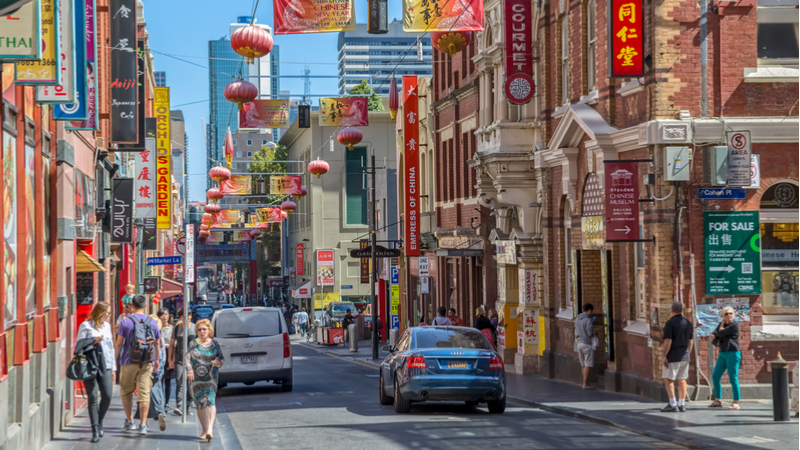The PRC diaspora in Australia
February 01 2018

- In 2015-16 the number of residents in Australia born in the People’s Republic of China (PRC) totalled approximately 526,000. That is, 2.2 percent of the Australian population.[1] This compares with:[2]
- UK 5 percent;
- New Zealand 2.5 percent;
- India 1.9 percent;
- Philippines 1 percent; and
- Vietnam 1 percent.
In 2005-06 the proportion of the Australian population born in the PRC had been 1.2 percent.[3]
Arrivals
Of the PRC-born residents in Australia:[4]
- 37.4 percent arrived between 2011-16;
- 22 percent arrived between 2006-2010;
- 12.3 percent arrived between 2001-05; and
- 28.3 percent arrived in 2000 or earlier.
Permanent migration
Australia’s permanent migration programme comprises skilled, family and special eligibility streams. Of the 183,608 permanent migration programme visas granted in 2016-17, migrants from the PRC accounted for 15.4 percent of total places.[5] This compares with:[6]
- India 21.2 percent;
- UK 9.3 percent;
- Philippines 6.6 percent;
- Pakistan 3.6 percent; and
- Vietnam 3 percent.
Note: These are the top six source countries for permanent migration to Australia.
In 2010-11 for the first time the PRC was the top source country of migrants.[7] In the years since it has consistently been the second largest source country of migrants, with India as the largest.
Naturalisation
In 2015-16, 133,126 people became Australian citizens. PRC migrants accounted for 5.2 percent of the total.[8]
This compares with:[9]
- India 16.5 percent;
- UK 15.7 percent;
- Philippines 6.3 percent;
- South Africa 4.2 percent; and
- Vietnam 3.1 percent.
Note: These are the top six source countries for migrants acquiring citizenship in Australia.
Between 2005-06 and 2009-10, the proportion of individuals with PRC citizenship assuming Australian citizenship fluctuated, hitting a five-year high of 9.3 percent in 2009-10. However, since 2011-12 the proportion has steadily declined, hitting a 10-year low of 5.2 percent in 2015-16. [10]
According to the 2016 census, 36.3 percent of PRC-born migrants are Australian citizens.[11] This contrasts with 47.3 percent in 2011.[12]
Language spoken at home
The 2016 census results showed that 41.9 percent of all overseas born Australian residents spoke only English at home. 46.8 percent spoke another language but also spoke English ‘very well or well’. 10.5 percent spoke another language and spoke English ‘not well or not at all’.[13]
Looking to PRC-born residents in Australia:[14]
- 2.6 percent of PRC-born residents in Australia spoke only English at home;
- 65.8 percent spoke another language but also spoke English ‘very well or well’; and
- 31 percent stated they spoke another language and spoke English ‘not well or not at all’.
Temporary entrants[15]
At December 31 2016 there were approximately 2.1 million temporary entrants in Australia. Temporary entrants include (but are not limited to) visitor visa holders, student visa holders and temporary skilled visa (subclass 457) holders.
The PRC was the second largest source country for temporary entrants in Australia at this time, with PRC nationals accounting for 8.7 percent of entrants. This compares with:
- New Zealand 30.9 percent;
- India 7.9 percent;
- UK 7.8 percent; and
- US 2.8 percent.
Note: these are the top five source countries for temporary entrants in Australia.
Student visa holders
In December 2016, the number of student visa holders in Australia totalled 355,760. The PRC was the largest source country for this visa category, with PRC nationals holding 19.9 percent of these visas. This compares with:
- India 14.7 percent;
- Nepal 6 percent;
- Vietnam 5.1 percent; and
- South Korea 4.5 percent.
Note: these are the top five source countries for student visa holders in Australia.
Since at least 2011 the PRC has been the top source country for holders of student visas in Australia.
Visitor visa holders
In December 2016, there were 565,760 visitor visa holders in Australia. The PRC was the second largest source country for this visa category, with PRC nationals holding 12.3 percent of these visas. This compares with:
- UK 16.5 percent;
- India 9.2 percent;
- US 7.2 percent; and
- Germany 4 percent.
Note: these are the top five source countries for visitor visa holders in Australia.
457 visa holders (temporary work (skilled))
In December 2016 there were 150,220 temporary skilled visa holders in Australia. The PRC was the third largest source country for this visa category, with PRC nationals holding 7 percent of these visas. This compares with:
- India 21.7 percent;
- UK 16.5 percent;
- Philippines 6 percent; and
- Ireland 4.1 percent.
Note: these are the top five source countries for 457 visa holders in Australia.
This fact sheet was prepared by Elena Collinson, Senior Project and Research Officer, Australia-China Relations Institute, University of Technology Sydney.
Sources and notes
This fact sheet’s focus is limited to residents in Australia born in the People’s Republic of China (PRC) and PRC nationals on temporary entry visas.
[1] Australian Bureau of Statistics, Migration, Australia, 2015-16, March 30 2017 <http://www.abs.gov.au/ausstats/abs@.nsf/mf/3412.0>.
[2] Ibid.
[3] Australian Bureau of Statistics, Migration, Australia, 2005-06, March 29 2007 <http://abs.gov.au/AUSSTATS/abs@.nsf/Lookup/3412.0Main+Features12005-06?OpenDocument>.
[4] Australian Bureau of Statistics, 2016 Census QuickStats Country of Birth – People in Australia who were born in China, 2016 Census <http://www.censusdata.abs.gov.au/census_services/getproduct/census/2016/quickstat/6101_036>.
[5] Department of Immigration and Border Protection, 2016-17 Migration Programme Report (Programme year to 30 June 2017) <https://www.homeaffairs.gov.au/ReportsandPublications/Documents/statistics/report-on-migration-program-2016-17.pdf>.
[6] Ibid.
[7] Department of Immigration and Citizenship, Trends in migration: Australia 2010-11 – Annual submission to the OECD’s Continuous Reporting System on Migration (SOPEMI) <https://www.homeaffairs.gov.au/ReportsandPublications/Documents/statistics/trends-in-migration-2010-11.pdf>.
[8] Department of Immigration and Border Protection, Annual Report 2015-16 <https://www.homeaffairs.gov.au/about/reports-publications/reports/annual/annual-report-2015-16/appendices/appendix-4>.
[9] Ibid.
[10] Data based on citizenship statistics from Department of Immigration and Citizenship annual reports; Department of Immigration and Border Protection annual reports 2005-06 to 2015-16.<https://www.homeaffairs.gov.au/ReportsandPublications/Documents/annual-reports/diac-annual-report-2005-06-full-version.pdf>.
[11] Australian Bureau of Statistics, 2016 Census QuickStats Country of Birth – People in Australia who were born in China <http://www.censusdata.abs.gov.au/census_services/getproduct/census/2016/quickstat/6101_036>.
[12] Australian Bureau of Statistics, 2011 Census QuickStats Country of Birth – People in Australia who were born in China <http://www.censusdata.abs.gov.au/census_services/getproduct/census/2011/quickstat/6101_0>.
[13] Australian Bureau of Statistics, 2016 Census QuickStats Country of Birth – People in Australia who were born in China <http://www.censusdata.abs.gov.au/census_services/getproduct/census/2016/quickstat/6101_036>.
[14] Australian Bureau of Statistics, 2016 Census QuickStats Country of Birth – People in Australia who were born in China <http://www.censusdata.abs.gov.au/census_services/getproduct/census/2016/quickstat/6101_036>.
[15] Department of Immigration and Border Protection, Temporary entrants in Australia, December 31 2016 <https://www.homeaffairs.gov.au/ReportsandPublications/Documents/statistics/temp-entrants-aus-31-dec-2016.pdf>.

